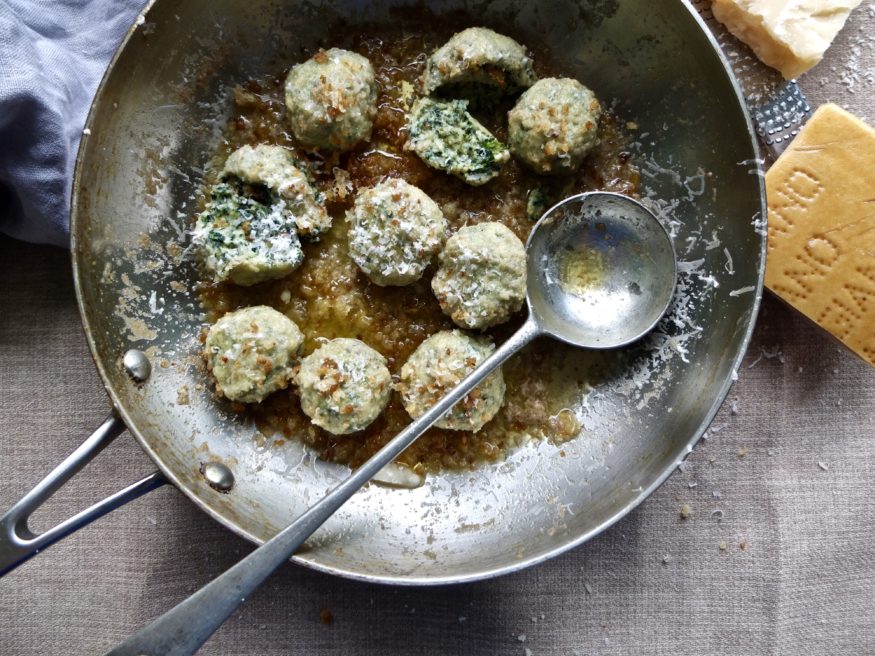Parmigiano Reggiano, Ricotta and Spinach Gnudi with Anchovy-Garlic Butter

This the second of two recipes I’ve developed for a paid partnership with Parmigiano Reggiano.
‘Have you ever made gnudi before?’ D dared to joke when I suggested this recipe. He’s referring to the time I made hundreds of them for a supper club and by the time I’d done a couple of practice runs and the actual event (220 required) I’d really had enough. The upshot is that I’m really good at making gnudi though, so you can now reap the benefits.
I served them with crab and pickled wild garlic buds but this time kept things more classic in an effort to show off the Parmigiano Reggiano. Now, let me tell you what I have learnt about gnudi. Firstly, there’s a lot of talk on the internet about how difficult they are to make. They are not. Second, you don’t need to leave them for days in the fridge to form a skin around the outside – a few hours will do just fine; basically, you can leave them in the fridge for anything between three hours and three days. After that, they tend to go a bit tough. Finally, it’s true that using expensive ricotta will save you time and taste better but it’s rubbish that the gnudi simply won’t work with supermarket ricotta (but you will need to strain it overnight). I made these gnudi with supermarket ricotta and frankly it makes a nice blank canvas at which to throw huge flavours.
One of those is the Parmigiano Reggiano, which you know is going to be excellent because its manufacture is governed by a strict set of rules, right down to the diet of the cows whose milk it’s made from. The rules specify that 50% of the cows’ diet must consist of ‘forage’ grown on the dairy farm and 75% of it must be local. It’s the forage that determines the positive bacterial flora, establishing a link with the land and therefore the cheese’s PDO status. The milk is raw when it’s used to make the cheese, and it’s combined with just natural calf rennet and salt. Rules like this please me greatly. See also: Neapolitan pizza and Parma ham.
What doesn’t please me is ‘rules’ people post on the internet which are simply incorrect. I urge you to try making gnudi then, particularly if you’ve been intimidated by them, as I once was! They’re incredible: fluffy cheese balls which are served with a sauce made entirely from butter. If that doesn’t get you excited then you’re on the wrong website.
Parmigiano Reggiano, Ricotta and Spinach Gnudi with Anchovy-Garlic Butter Recipe
Makes approx 28
300g ricotta
300g spinach
100g Parmigiano Reggiano, grated finely
3 egg yolks
40g plain flour
Coarse semolina, for coating and storing
8 anchovy fillets
4 cloves garlic (or more! Up to you)
100g butter
A squeeze of lemon juice
For the crumbs
200g stale sourdough (a day or two old, not rock hard)
3 tablespoons oil from a jar of anchovies
Place the ricotta into a brand new jay cloth or piece of muslin and tie it up at the top with string. Suspend this over a bowl in the fridge and leave overnight.
The next day, wash the spinach and put it in a saucepan with water still on the leaves. Gently wilt over medium heat with the lid on, stirring halfway through. Spread out to cool and then squeeze out as much water as possible. I find this is easiest using a clean cloth to squeeze it.
Chop the spinach finely and mix it with the strained ricotta, Parmigiano Reggiano, egg yolks, flour, and some salt. Roll into balls a bit smaller than a ping pong ball.
Make a bed of semolina on a plate and roll each ball in it. When all the gnudi are coated, pour more semolina on top and put them in the fridge, uncovered for at least 3 hours and up to 3 days.
Make the crumbs by blitzing the sourdough in a blender and frying in the anchovy oil until crisp. Drain on kitchen paper.
Make the sauce by melting the butter and gently melting the garlic and anchovies into it. Squeeze in some lemon juice to taste.
To cook the gnudi bring a pan of water to the boil and gently lower them in. They’ll take just a couple of minutes to cook and are ready when they float to the top. Pop them into the pan with the butter to take on a little colour and serve, scattered with the crumbs.